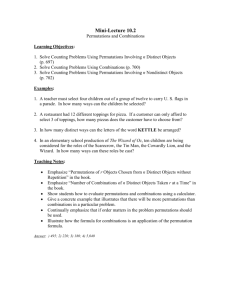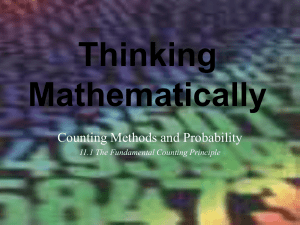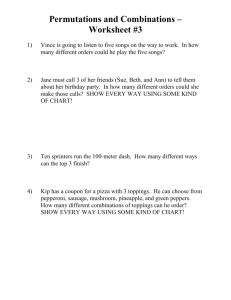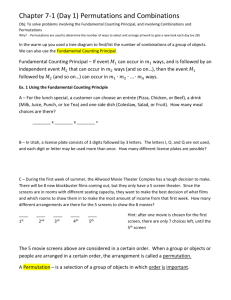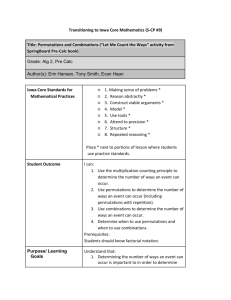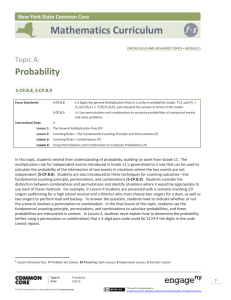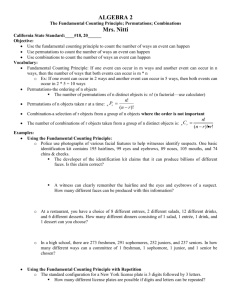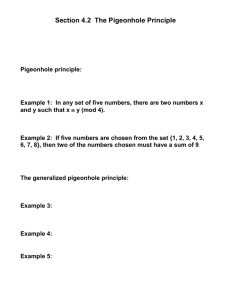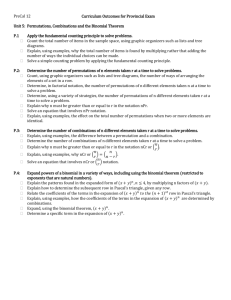CS 214_StudyGuideTest2
advertisement
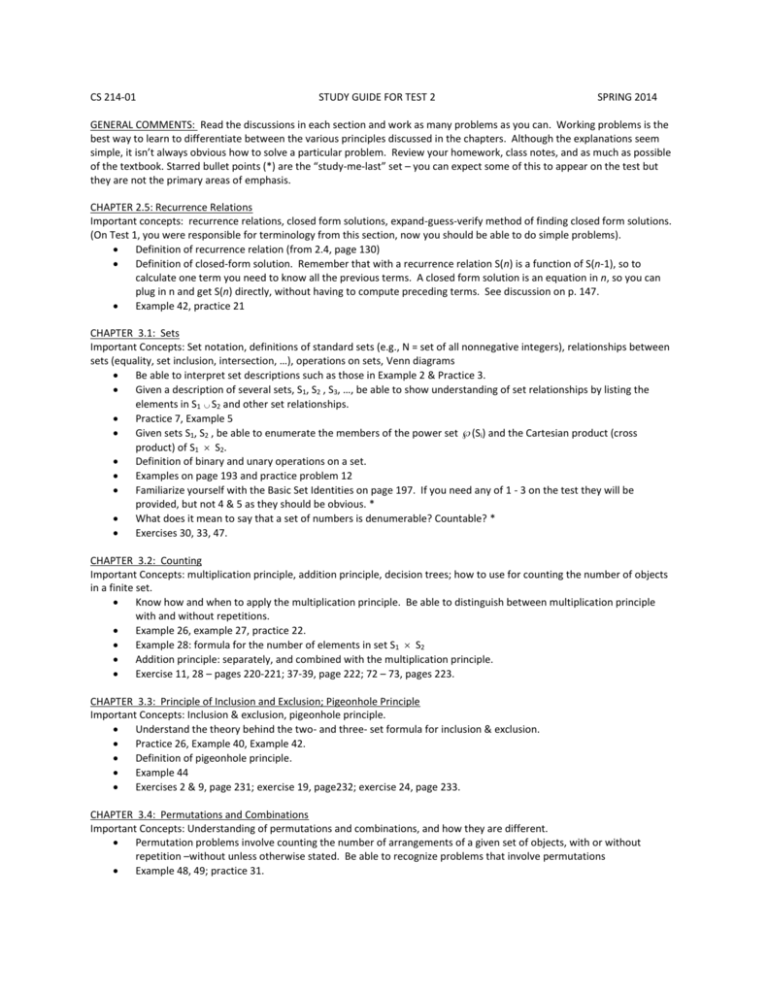
CS 214-01 STUDY GUIDE FOR TEST 2 SPRING 2014 GENERAL COMMENTS: Read the discussions in each section and work as many problems as you can. Working problems is the best way to learn to differentiate between the various principles discussed in the chapters. Although the explanations seem simple, it isn’t always obvious how to solve a particular problem. Review your homework, class notes, and as much as possible of the textbook. Starred bullet points (*) are the “study-me-last” set – you can expect some of this to appear on the test but they are not the primary areas of emphasis. CHAPTER 2.5: Recurrence Relations Important concepts: recurrence relations, closed form solutions, expand-guess-verify method of finding closed form solutions. (On Test 1, you were responsible for terminology from this section, now you should be able to do simple problems). Definition of recurrence relation (from 2.4, page 130) Definition of closed-form solution. Remember that with a recurrence relation S(n) is a function of S(n-1), so to calculate one term you need to know all the previous terms. A closed form solution is an equation in n, so you can plug in n and get S(n) directly, without having to compute preceding terms. See discussion on p. 147. Example 42, practice 21 CHAPTER 3.1: Sets Important Concepts: Set notation, definitions of standard sets (e.g., N = set of all nonnegative integers), relationships between sets (equality, set inclusion, intersection, …), operations on sets, Venn diagrams Be able to interpret set descriptions such as those in Example 2 & Practice 3. Given a description of several sets, S1, S2 , S3, …, be able to show understanding of set relationships by listing the elements in S1 S2 and other set relationships. Practice 7, Example 5 Given sets S1, S2 , be able to enumerate the members of the power set (Si) and the Cartesian product (cross product) of S1 S2. Definition of binary and unary operations on a set. Examples on page 193 and practice problem 12 Familiarize yourself with the Basic Set Identities on page 197. If you need any of 1 - 3 on the test they will be provided, but not 4 & 5 as they should be obvious. * What does it mean to say that a set of numbers is denumerable? Countable? * Exercises 30, 33, 47. CHAPTER 3.2: Counting Important Concepts: multiplication principle, addition principle, decision trees; how to use for counting the number of objects in a finite set. Know how and when to apply the multiplication principle. Be able to distinguish between multiplication principle with and without repetitions. Example 26, example 27, practice 22. Example 28: formula for the number of elements in set S1 S2 Addition principle: separately, and combined with the multiplication principle. Exercise 11, 28 – pages 220-221; 37-39, page 222; 72 – 73, pages 223. CHAPTER 3.3: Principle of Inclusion and Exclusion; Pigeonhole Principle Important Concepts: Inclusion & exclusion, pigeonhole principle. Understand the theory behind the two- and three- set formula for inclusion & exclusion. Practice 26, Example 40, Example 42. Definition of pigeonhole principle. Example 44 Exercises 2 & 9, page 231; exercise 19, page232; exercise 24, page 233. CHAPTER 3.4: Permutations and Combinations Important Concepts: Understanding of permutations and combinations, and how they are different. Permutation problems involve counting the number of arrangements of a given set of objects, with or without repetition –without unless otherwise stated. Be able to recognize problems that involve permutations Example 48, 49; practice 31. Difference between combinations and permutations (arrangements). Be able to tell the difference between a problem that requires combinations and one that requires permutations. Example 54 & 55, practice 32 & 34. Formulas for special cases of permutations and combinations * Exercises 5, 7, 16, 25. CHAPTER 3.5: Probability Important Concepts: Finite probability as a counting problem, probability distributions, conditional probability. Events, sample spaces, and calculation of probability as a function of set size. See page 252. Practice 39 and 40, Example 65 Probability distributions when all events are not equally likely. Practice 41 Conditional probability: definition, definition of independent events.* Exercise 1-5, 17-20, page 261 CHAPTER 4.1: Relations Definitions of binary relations: on a set, on multiple sets. Example 4, example 5, practice 1, practice 2 Properties of relations: reflexive, symmetric, transitive, antisymmetric. Be able to recognize the presence or absence of these properties when presented with a set Example 6, 7, practice 4 Definition of the closure of a relation. * Definition of relations that are partially ordered; be able to recognize relations that satisfy requirements for partial ordering (or that don’t satisfy them). Practice 8, example 10 Be able to identify and recognize characteristics of a Haase diagram. * Equivalence relations: know definition, be able to recognize relations as being (or not being) an equivalence relation. Set partitioning: definition, relation to equivalence relations. Practice 14 Exercise 1, 6, 12, 37 CHAPTER 4.2: Functions Definition of function; know terminology such as domain, codomain, range, image, preimage Practice 23, Example 29 Definition of onto, one-to-one (injective) and bijective functions. Inverse and identity functions. Exercises 1, 6, 9 See Table 4.2 (page 342) for all definitions of interest) THE TEST WILL STOP HERE
